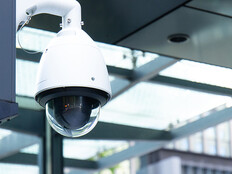360-Degree View
As state and local governments work to better watch and manage their budgets, proving the return on their investments becomes top priority. At the New Rochelle Police Department, in-car mobile surveillance has proved so valuable since it was first deployed in February that plans to outfit more of the fleet are already under way.
"We've seen a rapid return on our investment in in-car mobile surveillance as we've been able to use the video gathered to quickly discredit fraudulent claims and avoid costly legal fees, as well as improve standard operating procedures," says Nick Massaregli, systems engineer for the New Rochelle Police Department in New York.
New Rochelle police use the Panasonic Toughbook Arbitrator 360° system to capture, store, transfer and manage video. So far, Massaregli has equipped 11 of the 30 marked-car fleet vehicles with one or two high-definition video cameras focused on the front of the vehicle and a passenger compartment. The digital video and audio recorder can be used in stand-alone mode, or officers can connect it to their Panasonic Toughbook notebook computers for real-time viewing and playback.
Like New Rochelle, many law enforcement agencies across the country are deploying the Panasonic Arbitrator 360° system, which supports up to five cameras in one vehicle. In fact, police cars are the second-largest market globally, next to transit buses, for mobile video surveillance, says Niall Jenkins, senior research analyst at IMS Research. "The equipment has already been effective in assisting and protecting officers, and the systems are designed to protect the chain of custody, which is a must if the video is to be used as evidence," he says.
Roll Camera
New Rochelle's system is set to automatically record based on a number of triggers, such as when the sirens or light bar turn on or if the car's speed rapidly increases. An officer also can manually start the video from the in-car console or Arbitrator CommandR software on a Toughbook. Department supervisors and dispatchers can monitor any cruiser's video feed via the software.
Once a cruiser is in range of the station, the Arbitrator 360°'s wireless transmitters automatically upload recorded video to a department server via Wi-Fi so officers don't have to remember to swap out a CD, DVD or VHS tape. In addition, Massaregli configured the system to automatically prerecord 20 seconds of video so department leaders have better context for each incident. "We do this so there is no dispute as to what transpired prior to the infraction," he says. For instance, the Arbitrator 360° can capture a car speeding through an intersection right before the officer turns on his or her light bar.
Although the department doesn't have specific numbers, leaders have noticed a decrease in complaints and an improved ability to quickly address the feedback they do receive. "People are still coming in and voicing their concerns, but once we show them the video, any discrepancies are resolved," Massaregli says.
Improving Officer Safety
The Lincoln Police Department in Nebraska, a user of the previous generation of the Arbitrator, appreciates the upgrades in the Arbitrator 360°, including the ability to use a handful of cameras in a single car. "Initially, we weren't that excited by the support for multiple cameras. Then, several incidents during our beta test made it clear this was an important option," says Sgt. Todd Beam.
2,592
Number of hours the Arbitrator 360° can record
During the department's pilot, Beam had outfitted a car with four cameras pointed from the front, from the back, to the side and toward the backseat. The department saw immediate results when video helped disprove a person's claim of police abuse. "It showed there was no such contact," Beam says. "Without that comprehensive view, it would have been the officer's word against his." The city purchased enough Arbitrator 360°s to equip 49 of the 140-car fleet. Beam hopes to eventually purchase more.
In addition to arbitrating disputes, Beam says the system has improved standard operating procedures and on-the-job safety, such as how an officer approaches a stopped vehicle. He says officers are trained to stay within the camera zones and wear their wireless microphones so they can be properly recorded inside and outside the cruiser. (There is also a microphone in the cruiser.) Having a full view of the area via the notebook is also critical to understanding how to handle a situation in-person and remotely. For instance, a chief can see from a remote location that an officer is in trouble and dispatch more units.
Sparking Innovation
The Lincoln Police Department sees great potential for the Arbitrator 360°, including helping to tackle the collegiate city's binge-drinking and noisy party problems. It plans to patrol areas where bars are potentially overserving patrons and collect video evidence to build cases for the Liquor Control Board to revoke liquor licenses if necessary. It also plans to record areas where loud parties recur to enter into evidence at disturbance-of-the-peace hearings.
Go to www.statetechmag.com/storage410 to read about storage aspects of mobile surveillance systems.
Police officers can tag and categorize videos with pertinent information, such as "drunk driver" or "speeding." But Beam eventually wants the technology to automatically match recordings with the warning or ticket that was issued to help connect the dots and reduce the time it takes to research complaints. Panasonic representatives say they are working on this capability with e-ticket manufacturers.
New Jersey's Middle Township Police Department is also eager for such integration. Chief Christopher Leusner says it will further justify the $160,000 cost to equip all 23 cars in his fleet with the Arbitrator 360°, which he deployed in 2009. Already, the technology has been used to exonerate officers in three separate complaints. In fact, the department considers it a deterrent and has publicized its existence to citizens.
In New Rochelle, officials hope to use the Arbitrator 360° cameras for license plate recognition. The cameras will be able to detect a license plate, and an officer can check that plate against the department's internal database to see if it is a stolen vehicle or prompts any other alerts. The officer can then take action.
"Our experience with the ÂArbitrator 360° has been so positive that we're planning to make sure that all of the sector vehicles that are in operation 24 hours a day are outfitted with the system," Massaregli says.
Getting Comfortable
Police officers might initially be wary of in-car mobile surveillance because they're fearful of being watched or judged.
Here are some tips for acclimating them to the technology.
- Show them all the components of the system, including the remote monitoring capabilities, so they don't think there is some hidden agenda.
- Let them help choose the triggers for when the video should start recording. Panasonic offers 16 options, including when the siren goes off or when the cruiser is hit.
- Illustrate how the cameras could protect them. For instance, if the officer is stopped and a potential attacker is approaching the car, the officer can assess the situation before an attack occurs.
- Explain how the system can be used to exonerate officers of false complaints and other issues that could affect their careers.
- Start to use the collected video as a training tool to demonstrate proper procedure and gather input from officers about what was done well and poorly in each instance.








